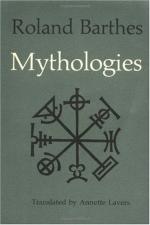|
This section contains 797 words (approx. 2 pages at 400 words per page) |

|
Myths
Myths, according to the author, are intellectual constructs—language (visual as well as linguistic) shaped to give a particular, intended, propagandistic message about the human experience. It is important to note that for the author, myths are essentially bourgeois, constructed by the working / non-intellectual class to reinforce bourgeois experiences, perceptions and values. He develops this theory throughout the book. At no point does he explore the perspective, developed in the writings and theories of mythologists like Joseph Campbell and Carl Jung, that myths are profound expressions of fundamental human spiritual and/or psychological experiences.
Symbols
Symbols are, for the author, the components of myth—words, images, ideas, are all symbols which, when combined, form a lesson, story or explanation of human experience.
Archetypes
The term "archetype" is used to describe a universal human experience and/or position, each with a defining set of conditions. For...
|
This section contains 797 words (approx. 2 pages at 400 words per page) |

|




